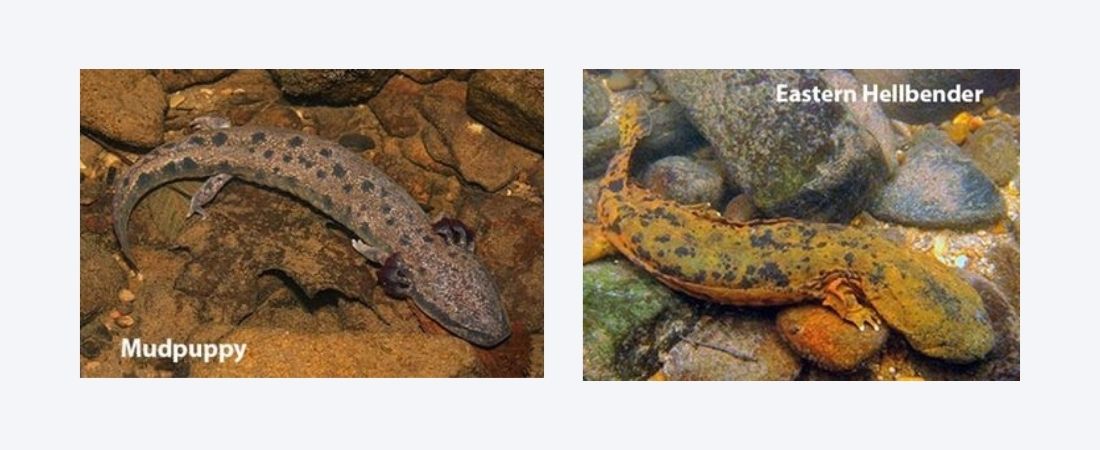
As opening day of Hatchery Supported Trout Waters approaches (April 2), wildlife biologists at the N.C. Wildlife Resources Commission are asking the public, particularly anglers, to report sightings of mudpuppies and hellbenders to the agency. Both species of aquatic salamanders are found in western North Carolina.
These two giant salamanders often get confused with one another, but they have distinct differences. The mudpuppy has light brown, smooth skin that is typically speckled with spots, and red external feathery gills it retains through its whole life. It’s smaller than the hellbender, averaging around 10 inches in length as an adult. It primarily lives in deep rivers, lakes, large ponds and reservoirs, but also thrives in unpolluted streams like the hellbender.
The hellbender, also called a “water dog,” “snot otter,” or “Alleghany alligator,” is the largest aquatic salamander in North America, averaging 16 to 17 inches long. It has a flat, broad head and flattened body, wrinkly skin on its sides and is brown – sometimes mottled with dark splotches. It’s typically only found in fast moving, clean mountain streams.
Both species are listed as species of special concern in North Carolina, and Wildlife Commission biologists want to know more about their distribution in the state and how their populations are faring.
“We know less about mudpuppies than we do about hellbenders, but we’d like to know much more about both,” said Lori Williams, a wildlife diversity biologist with the Wildlife Commission. “Challenging logistics in lake systems have made it difficult for us to conduct mudpuppy population surveys, but those habitats may be hot spots. Mudpuppies are attracted to baited hooks in lakes and deep rivers, so anglers fishing from boats may catch one. We need anyone who fishes deep river sites and impounded waters to let us know if they find one.”
Hellbenders, on the other hand, have been the focus of a long-term inventory and monitoring study the agency has been conducting with partners since 2007. Their populations have decreased mainly due to declining water quality and habitat degradation, and to a lesser degree, ill treatment from anglers who mistakenly think they decrease trout populations. The latter is not true; however, both hellbenders and mudpuppies may go after fish on a line or stringer when scavenging for an easy meal.
Their main source of prey is crayfish, but they will also eat minnows, snails, tadpoles, worms, discarded bait or other injured or dead animals. Game fish, like trout and bass, will eat young or larval mudpuppies and hellbenders.
Neither the mudpuppy nor the hellbender is poisonous, venomous, toxic or harmful to humans, although they may try to bite as a defensive reaction if someone tries to pick them up. If sighted, they should be left alone and reported. Williams asks that their location be noted (physical location or GPS coordinates), a photo snapped if possible, and any other details shared with her via email. People can also call the Wildlife Commission’s NC Wildlife Helpline, 866-318-2401, and provide details of the observation.
It is illegal to take, possess, transport or sell mudpuppies or hellbenders, or attempt to do so. The violation is a Class 1 misdemeanor, which can result in a fine and up to 120 days in jail. If anglers happen to catch one on by hook and line, they should carefully remove the hook if it is safe to do so without harming the animal, or cut the line as close as possible to the hook and return the salamander back to the water.
Learn more by visiting the NC Partners in Amphibians and Reptile Conservation’s mudpuppy webpage and the Wildlife Commission’s hellbender webpage.
Via N.C. Wildlife Resources Commission

